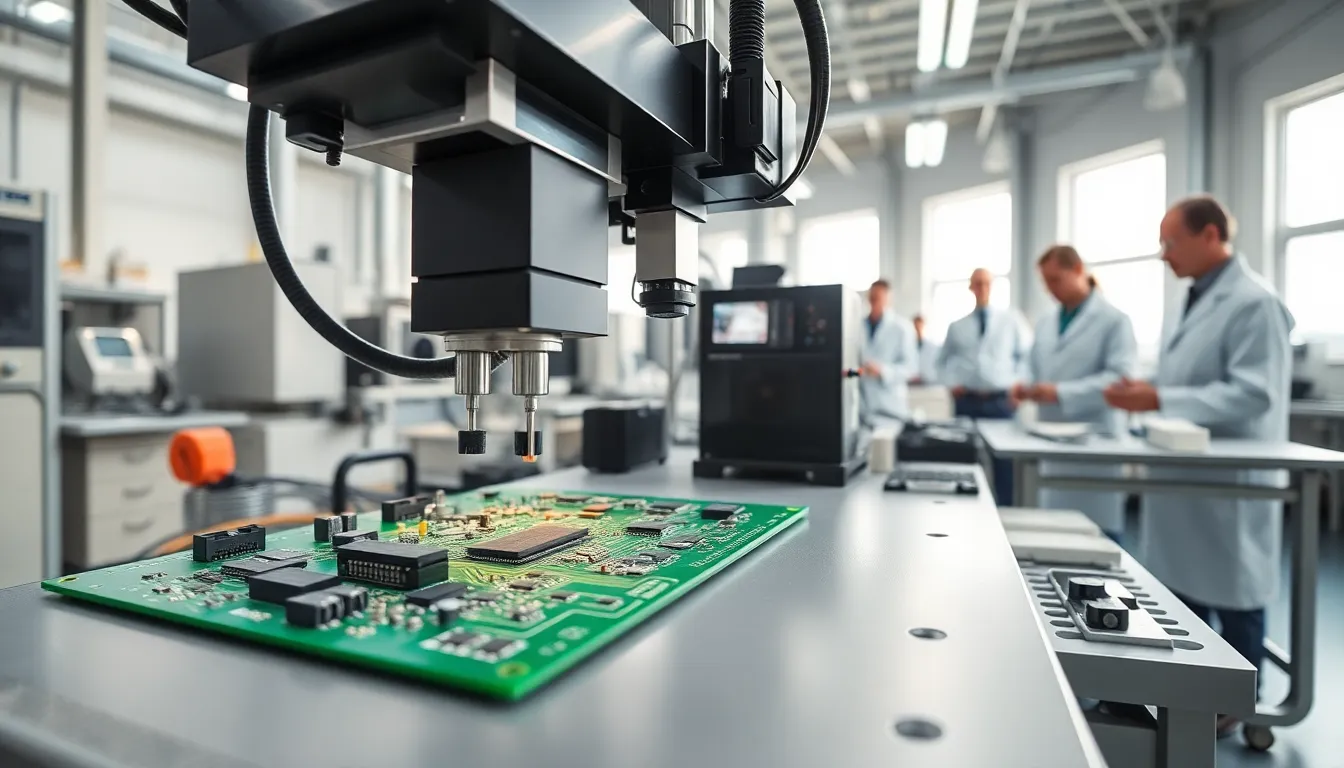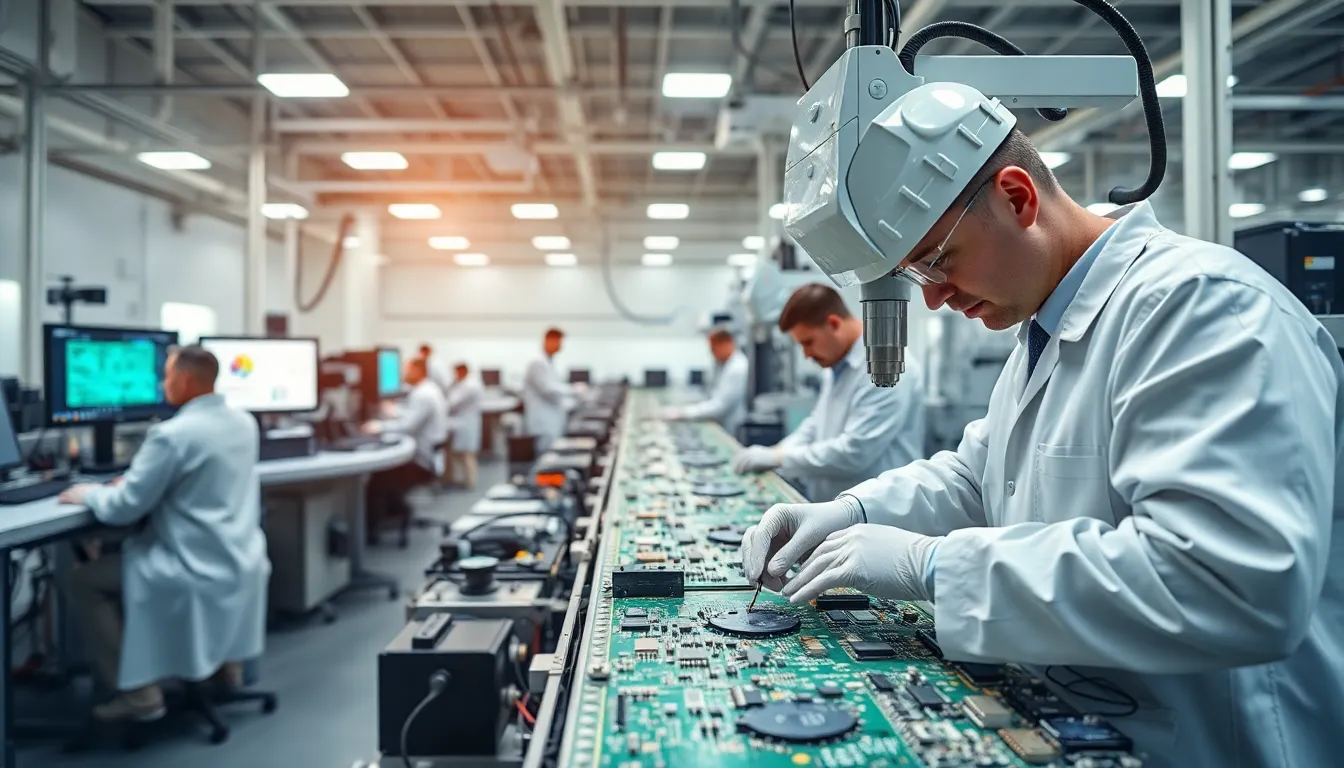PCB assembly service transforms bare printed circuit boards into functional electronic devices through component mounting, soldering, and rigorous testing using surface mount technology, through-hole technology, or mixed assembly methods. Trusted providers like OurPCB in China offer comprehensive solutions including component sourcing, automated optical inspection, and both turnkey and consigned assembly options whilst maintaining ISO certification and IPC standards compliance. When selecting a partner, electronics manufacturers should evaluate technical capabilities for complex designs, supply chain reliability, quality assurance processes including functional testing, lead time flexibility, and dedicated engineering support to ensure consistent production quality and timely delivery for both prototype and volume manufacturing runs.
Key Takeaways
- PCB assembly service transforms bare PCBs into fully functional electronic circuits by mounting and soldering components.
- Choosing a reliable PCB assembly service provider, like OurPCB, ensures high-quality production, timely delivery, and effective support.
- PCB assembly includes SMT, THT, and mixed technology options to handle various complexity and design needs.
- A streamlined PCB assembly process—from solder paste application to inspection—guarantees efficient, defect-free manufacturing.
- Quality control, including AOI and functional testing, is essential in PCB assembly to prevent defects and ensure product reliability.
What Is PCB Assembly?

PCB assembly, often abbreviated as PCBA, is the process of mounting and soldering electronic components onto a bare PCB to create a complete, operational circuit. The finished product is used in everything from consumer electronics to industrial control systems. Unlike PCB fabrication, which produces only the board, assembly is about adding components and bringing the board to life.
PCB assembly involves several stages, including the placement of resistors, capacitors, integrated circuits, and connectors, either by machine or by hand, depending on complexity and quantity. Service providers like OurPCB manage every step, from sourcing components to performing visual and automated inspections, ensuring a functional end product that meets specifications.
Types of PCB Assembly Services
High-quality PCB assembly services are categorized based on the techniques and project requirements. The main types are:
Surface Mount Technology (SMT)
SMT is the most common assembly method used today. Electronic components are directly mounted onto the PCB’s surface, allowing for smaller, lighter, and more complex assemblies. SMT is suitable for high-volume production and products requiring miniaturization.
Through-Hole Technology (THT)
In through-hole assembly, component leads are inserted into holes drilled through the PCB and then soldered on the opposite side. THT provides stronger mechanical bonds and is ideal for components that endure mechanical stress or for prototyping.
Mixed Technology Assembly
Some designs require both SMT and THT components. Mixed technology assembly combines the benefits of each method, enabling flexibility in design and function. For example, OurPCB offers mixed assembly lines to support complex products with both surface-mounted chips and through-hole connectors.
Turnkey and Consigned Assembly
Turnkey services mean the assembly partner handles everything, from parts procurement to final inspection and delivery. Consigned assembly is when the client supplies all or some of the components. OurPCB provides both options, allowing clients to choose the most cost-effective and efficient path.
Key Steps in the PCB Assembly Process
A streamlined and reliable PCB assembly process involves multiple carefully managed steps:
- Solder Paste Application: Solder paste is applied to areas of the PCB where components will be mounted. Precision is key to ensure strong and reliable joints.
- Component Placement: Automated pick-and-place machines set components in their designated locations. Manual placement might be used for rare or delicate components.
- Soldering: For SMT, a reflow oven melts the solder paste, securing components. Through-hole parts are typically soldered using wave soldering or by hand.
- Inspection and Testing: Visual, automated optical inspection (AOI), and X-ray checks reveal misplaced or defective solder joints. Functional testing may also be performed per client requirement.
- Final Assembly and Packaging: Finished assemblies are cleaned, tested again if necessary, and packaged for shipment.
With sophisticated equipment and a trained team, companies like OurPCB ensure each step meets international standards, offering fast turnaround while maintaining quality.
Choosing the Right PCB Assembly Partner
Selecting a PCB assembly partner directly affects your product’s reliability and performance. Here’s what matters:
- Technical Capabilities: Can your partner manage complex designs or high layer counts? OurPCB, for example, provides both prototype and full-production capabilities, handling everything from simple single-sided boards to multilayer assemblies.
- Component Sourcing: Trusted providers have reliable supply chains, preventing delays and substandard components. OurPCB maintains a network of verified suppliers, ensuring quality parts for every order.
- Quality Assurance: Consistency is vital. Look for ISO-certified partners with clear quality protocols. OurPCB‘s adherence to IPC standards is a key reason clients return project after project.
- Lead Time and Flexibility: Can they meet your production schedule, and do they accommodate urgent runs or engineering changes? OurPCB is known in China and abroad for its efficient project management and timely delivery.
- Service and Support: A strong partner communicates clearly, supports design for manufacturability, and helps resolve issues quickly. OurPCB assigns dedicated project engineers for personalized support throughout your project lifecycle.
Making a careful supplier choice means fewer headaches and a more reliable product.
Quality Control and Testing in PCB Assembly
Quality control is non-negotiable in PCB assembly. Defects can lead to costly product failures or even safety risks. The best assembly providers carry out rigorous testing and inspection at several stages:
In-Process Inspection
Automated Optical Inspection (AOI) systems check for soldering mistakes, missing parts, and alignment problems directly after placement and soldering. X-ray inspection is used for fine-pitch components and BGAs that hide solder joints under the device.
Functional Testing
Once assembled, some boards undergo in-circuit and functional testing to verify electrical performance. This step simulates the board’s operation in the end device, revealing any latent faults or poor solder connections.
Continuous Improvement
Top firms, including OurPCB, continuously review production data to find root causes of defects, ensuring each project benefits from lessons learned. OurPCB‘s quality processes are built on international standards and a culture of accountability, resulting in reliable performance for every batch.
Frequently Asked Questions about PCB Assembly Services
What is a PCB assembly service and why is it important?
A PCB assembly service refers to the process of mounting and soldering electronic components onto a bare printed circuit board (PCB), creating a functional device. This step is crucial for transforming designs into operational electronics used in various industries.
What types of PCB assembly services are available?
The main types of PCB assembly services include Surface Mount Technology (SMT), Through-Hole Technology (THT), and mixed technology assembly, which combines both. Providers may offer turnkey solutions, supplying all components, or consigned assembly, where clients provide parts.
How do I choose the right PCB assembly partner?
Selecting the right PCB assembly partner involves evaluating their technical capabilities, quality certifications, component sourcing reliability, flexibility for urgent orders, and level of customer support. Choosing an experienced company helps ensure product reliability and timely delivery.
What quality control processes are involved in PCB assembly?
Quality control in PCB assembly includes automated optical inspections (AOI), X-ray checks for hidden solder joints, in-circuit and functional testing, and continuous improvement based on production data. These steps help prevent defects and ensure dependable end products.
How does SMT differ from THT in PCB assembly?
Surface Mount Technology (SMT) mounts components directly on the PCB’s surface, allowing smaller, denser assemblies ideal for high-volume production. Through-Hole Technology (THT) involves inserting component leads into holes and soldering them, offering stronger mechanical bonds suited for robust or prototype applications.
What should I look for in a top PCB assembly service provider?
A top PCB assembly provider should have ISO certifications, proven quality assurance processes, reliable supply chains for components, fast turnaround times, and personalized support from knowledgeable project engineers.
